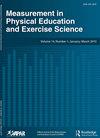不同信号处理方法对学龄前儿童加速度振幅范围的影响
IF 1.9
4区 教育学
Q2 EDUCATION & EDUCATIONAL RESEARCH
Measurement in Physical Education and Exercise Science
Pub Date : 2021-12-26
DOI:10.1080/1091367X.2021.2009836
引用次数: 0
摘要
摘要本研究探讨了1)对使用不同信号处理技术分析的加速度计数据应用自动校准算法的影响,以及2)这些技术如何改变信号成分。使用学龄前儿童数据集(n=137;4.31±0.87岁;右髋关节活动加速度计(100Hz),24小时/7天),计算矢量幅度(VM)作为参考;应用高通、带通和低通滤波器,计算了“欧几里得范数负一”(ENMO)。创建振幅概率分布函数以比较1)未校准数据与校准数据,以及2)跨技术的振幅分布。结果表明,校准校正对ENMO、VM低通和VM数据有显著影响,但对VM高通和带通数据的影响最小。比较不同的技术,结果显示,根据ENMO得出的输出最低,其次是VM高通/VM带通和VM低通/VM,结果非常相似。本文章由计算机程序翻译,如有差异,请以英文原文为准。
Comparison of Different Signal Processing Methodologies and Their Impact on the Range of Acceleration Amplitudes Experienced by Preschool-Aged Children
ABSTRACT This study explored 1) the effect of applying an autocalibration algorithm on accelerometer data analyzed using different signal processing techniques and 2) how these techniques changed the signal composition. Using a dataset of preschoolers (n = 137; 4.31 ± 0.87 years; Actigraph accelerometers (100 Hz) on right hip 24 hours/7 days) the vector magnitude (VM) was calculated as a reference; highpass, bandpass and lowpass filters were applied and the “Euclidean Norm Minus One” (ENMO) was calculated. Amplitude probability distribution functions were created to compare the 1) uncalibrated versus calibrated data and, 2) amplitude distribution across the techniques. Results showed that the calibration correction significantly impacted ENMO, VM lowpass and VM data, but the impact on VM highpass and bandpass data was minimal. Comparing across the techniques, results showed the lowest outputs were derived according to ENMO, followed by the VM highpass/VM bandpass and the VM lowpass/VM which yielded very similar results.
求助全文
通过发布文献求助,成功后即可免费获取论文全文。
去求助
来源期刊

Measurement in Physical Education and Exercise Science
Medicine-Orthopedics and Sports Medicine
CiteScore
4.20
自引率
33.30%
发文量
24
期刊介绍:
The scope of Measurement in Physical Education and Exercise Science (MPEES) covers original measurement research, special issues, and tutorials within six substantive disciplines of physical education and exercise science. Six of the seven sections of MPEES define the substantive disciplines within the purview of the original research to be published in the journal: Exercise Science, Physical Activity, Physical Education Pedagogy, Psychology, Research Methodology and Statistics, and Sport Management and Administration. The seventh section of MPEES, Tutorial and Teacher’s Toolbox, serves to provide an outlet for review and/or didactic manuscripts to be published in the journal. Special issues provide an avenue for a coherent set of manuscripts (e.g., four to five) to collectively focus in-depth on an important and timely measurement-related issue within the scope of MPEES. The primary aim of MPEES is to publish high-impact manuscripts, most of which will focus on original research, that fit within the scope of the journal.
 求助内容:
求助内容: 应助结果提醒方式:
应助结果提醒方式:


